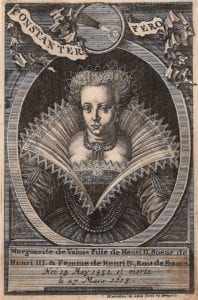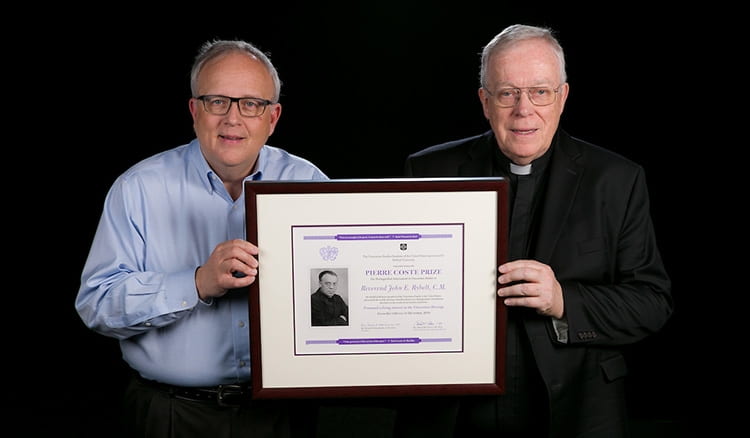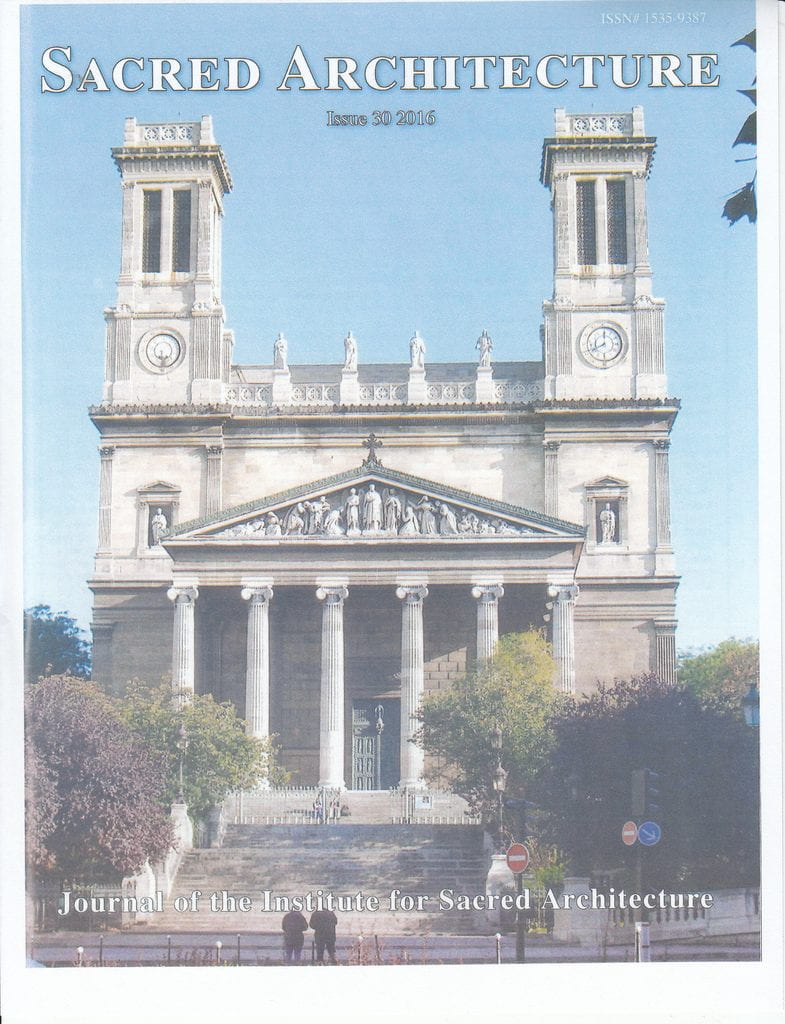This French press photo dated July 2, 1942 shows Daughters of Charity in Paris preparing packages to be sent to French prisoners of War in Stalag VIIa. Wikipedia has the following entry with respect to this camp:” Stalag VII-A (in full: Kriegsgefangenen-Mannschafts-Stammlager VII-A) was Germany’s largest prisoner-of-war camp during World War II, located just north of the town of Moosburg in southern Bavaria. The camp covered an area of 35 hectares (86 acres). It served also as a transit camp through which prisoners, including officers, were processed on their way to other camps. At some time during the war, prisoners from every nation fighting against Germany passed through it. At the time of its liberation on 29 April 1945, there were about 80,000 prisoners in the camp, mostly from France and the Soviet Union. Many others were billeted in Arbeitskommando working in factories, repairing railroads or on farms.”
Author: bcicirel
DePaul University: St. Vincent’s Reading List
Memoires de la Reyne Marguerite, by Marguerite de Valois and Auger de Mauléon. Brussels: F. Foppens, 1658.
Call Number: SpC. 944.031092 M331mr1658
A full-text version of this volume may be viewed here.
As far as we can tell, the young Vincent de Paul arrived in Paris by late 1609 or early 1610 and took up a position as one of the chaplains in the household of Queen Marguerite de Valois. The Queen was one of the daughters of King Henry II of France and Catherine de’ Medici, and sister to three French kings: Francis II, Charles IX, and Henry III. From 1572 until 1599 she was married to the Protestant Henry of Navarre as he struggled to win the French throne. Her marriage to Henry (eventually crowned King Henry IV of France) was childless, and since the new Bourbon King desperately desired an heir their union was annulled in 1599. Henry IV quickly married Marie de’ Medici and produced an heir he needed to secure the dynasty: the future Louis XIII. Marguerite spent the last sixteen years of her life living in her Left Bank palace in Paris.

Marguerite de Valois
Both Louis Abelly and Pierre Coste portray Vincent de Paul’s three years of service to the queen as a key period of conversion in the life of the saint. According to their accounts, this period saw Vincent being publicly accused of theft of by a roommate, his temptation against faith, and his service to the sick-poor at the charity hospital not far from the queen’s palace. Contemporary historiography has raised serious doubts about these accounts. In 1613, Vincent de Paul left the queen’s service and entered into service to the powerful ducal family of Philippe-Emmanuel de Gondi, Duke de Retz. Marguerite of Valois died in Paris at the age of 61 on 27 March 1615.
Marguerite as a Valois princess and as the wife of Henry of Navarre was a witness to, and played a central role in, the last phases of France’s long religious wars and the struggle for succession. At times she was a pawn in the struggles (she was held under house arrest by her brother Henry III for eighteen years), while at others she was an independent actor. She was an intelligent, articulate, beautiful, stylish, and highly literate princess who was simultaneously worldly and conventionally pious. Her historic role and accomplishments have always been under-appreciated because of the double-standards of historiographic misogyny.
The present work is a 1658 edition of her famous memoirs, first published in 1628. The work traces her life up to 1582 and is filled with fascinating insider details of the royal and political struggles of the period. The volume proved very popular and quickly went through many editions in Vincent’s lifetime.
!t is More than Just the Dreamers
In “It is More Than Just the Dreamers,” Rev. Craig Mousin, J.D., discusses the disruptive impacts that changes to the enforcement priority policies established by the Obama Administration are having in communities across the board. Our country was founded on the promise of Equality that is a necessary component of democracy. That promise is compromised by the fractures created in our communities by the fears created among immigrant populations, whether citizen or unauthorized, that ultimately impact public health, safety, and economics. The impact, then, is felt in more than the immigrant population. It is evidenced in work communities, academic communities, worshiping communities, and neighborhoods. The broken immigration system in the United States leaves courts unable to provide legal redress in a timely manner and the chaos that ensues leaves a trail of broken families and broken dreams. What must be done?
 The Rev. John E. Rybolt, C.M., is the recipient of the 2016 Pierre Coste Prize, which was presented Dec. 12 by the Vincentian Studies Institute. Fr. Rybolt, who was ordained in 1967, is a Vincentian scholar-in-residence at DePaul University. He receives the honor in part for his recently published seven-volume global history of the Vincentian community that dates back to its beginning in 1625.
The Rev. John E. Rybolt, C.M., is the recipient of the 2016 Pierre Coste Prize, which was presented Dec. 12 by the Vincentian Studies Institute. Fr. Rybolt, who was ordained in 1967, is a Vincentian scholar-in-residence at DePaul University. He receives the honor in part for his recently published seven-volume global history of the Vincentian community that dates back to its beginning in 1625.
French Missionaries and the Roman Catholic Priesthood in the United States,1789-1870
Fall Quarter 2017 DRMA Lecture About the Lecturer: Dr. Michael Pasquier is Associate Professor of Religious Studies and Jaak Seynaeve Professor of Christian Studies at Louisiana State University. He specializes in the history of religion in the United States, with areas of concentration in American Catholicism, religion in the U.S. South, and religion and the environment. He is the author of Fathers on the Frontier: French Missionaries and the Roman Catholic Priesthood in the United States, 1789-1870 (Oxford University Press) and Religion in America: The Basics (Routledge), as well as editor of the book Gods of the Mississippi (Indiana University Press) and producer of the documentary film Water Like Stone. His work has been supported by the American Academy of Arts and Sciences, the National Endowment for the Humanities, and the National Endowment for the Arts.
The Woman Elizabeth Ann Seton: 1804–1812
Mary Donovan examines Elizabeth Seton’s experience as a widow and as a mother of a teen daughter and explores the impact of two of Elizabeth’s closest relationships. In these years, the most important relationships in Elizabeth’s life were with her husband’s friend Antonio Filicchi, who played a great role in her conversion, and her daughter Anna. After her husband’s death, Elizabeth had to construct a new identity for herself, and the process is best documented in her correspondence with Filicchi. The two struggled with affection for each other, but ultimately she looked on him as a spiritual friend and he acted as her benefactor. Elizabeth found it difficult to believe she could love her children deeply without losing God’s love but eventually reconciled the two. With time, she learned to put Anna’s needs ahead of her own and respected Anna’s initial reluctance to join the Sisters of Charity. Anna’s death led Elizabeth to greater trust in God.
“The Woman Elizabeth Ann Seton: 1804-1812” is an article in the Vincentian Heritage Journal, Volume 14, Issue 2, Article 4 available at: https://via.library.depaul.edu/vhj/vol14/iss2/4
Newsnote: The Many Faces of Vincent de Paul: Nineteenth Century French Romanticism and the Sacred
In the new year the DePaul University Art Museum will host an exhibition guest curated by Rev. Edward R. Udovic, C.M., Ph.D. This special exhibition is titled: “The Many Faces of Vincent de Paul: Nineteenth Century French Romanticism and the Sacred. Sculptures, holy cards, textiles, decorative arts and prints from the university’s collection will explore how Romanticism impacted the iconic representations of Vincent de Paul at the dawn of the modern era.
For more information: http://museums.depaul.edu/exhibitions/the-many-faces-vincent-de-pau…
Our Entire Lives Are But a Moment Soon Gone
“Our Entire Lives are but a Moment Soon Gone” is a chapter in the book Saint Vincent de Paul: His Mind and His Manner by Jack Melito, C.M. which was published in 2010 by the Vincentian Studies Institute, DePaul University, Chicago, IL. The book is currently out of print.
Saint Vincent de Paul lived a long life and accomplished an extraordinary body of works of charity, not only in Paris, but throughout France and beyond. How did he have such an impact? This reading suggests that it was Vincent’s focused sense of urgency in his appreciation of time. Long life itself was not as important as using our time fulfilling that mission to which God has called us.
Toward the end of his life, Saint Vincent de Paul reflected on his use of the time given him: had he used it to the best of his ability? Was each precious moment lived in service of the poor? It was his appreciation of the economy of time and his prudent use of his time that drove him to accomplish such a great opus omnia of charitable works.
Pictures from 2016 and all that our Scholars participated in!
Peace Vigil
2016 Spring Quarterly InterReligious Celebration


